 Madrid, Spain – Thursday, May 6th, 2010
Madrid, Spain – Thursday, May 6th, 2010
A few years ago I would have harshly criticized anyone using the term ‘credit’ to refer to a roller coaster they’ve ridden, which seemed to be when that memetic virus was first spreading to all corners of the online coaster enthusiast realm. Bear in mind my negative experience was shaded significantly by the conversations of blowhard halfwits where one person would attempt to end a discussion by claiming, “yeah, well I have more than 100 more credits than you [editor’s note: mostly obscure children’s coasters] so that makes your opinion a lot less valid than mine, nur nur nur.” The fatuousness of this argument aside, the very concept of calling a coaster a ‘credit’ with the goal of achieving highest total numerical count seemed to be an egregious cheapening, if not wholly contrary to the spirit of why one would want to travel the nation to ride roller coasters. One should enjoy the experience for what it means to them in the moment, appreciate the unique, non-numerical identity of each ride, and appraise their history of worldwide coaster exploits qualitatively, not quantitatively.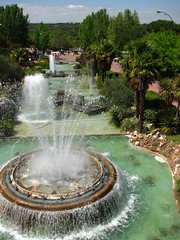
Sometime in the summer of 2007 when I had heard enough of people counting their credits when they had been to barely three parks, curiosity finally got the better of me and I decided to finally sit down and list all the coasters I had experienced in my lifetime. When I finished I discovered that my recent visit to Cedar Point made Maverick the coaster that rounded my count off to a crisp 200, a number that exceeded even my higher estimations for what my track record would have been. But perhaps more surprisingly, I discovered how much fun it was to be able to look at my entire life’s experience worth devoted to the hobby of roller coaster riding in a singular, scrollable list. Now that I was visiting parks with the background knowledge that what I accomplished that day would be forever imprinted on this personal list, I found myself willing to sample things I normally wouldn’t have bothered with. A rare visit to Stricker’s Grove on one of their only two operating days of the season meant I was more willing to delegate my limited time to one ride on the Teddy Bear and two on the Tornado, rather than just three rides on the Tornado as I might have done in years past. The next year it started getting more aggressive, a large Pennsylvania and New Jersey trip included rest stops at small parks I before wouldn’t have even bothered with even if I had driven right by, such as DelGrosso’s Park or Dutch Wonderland. What’s more, I felt somewhat guilty to find I was even making an effort to give small children’s coaster a whirl at least once, although I was somewhat appeased by the discovery that many children’s coasters are more violent than most of their 200ft. tall brethren.
The next year it started getting more aggressive, a large Pennsylvania and New Jersey trip included rest stops at small parks I before wouldn’t have even bothered with even if I had driven right by, such as DelGrosso’s Park or Dutch Wonderland. What’s more, I felt somewhat guilty to find I was even making an effort to give small children’s coaster a whirl at least once, although I was somewhat appeased by the discovery that many children’s coasters are more violent than most of their 200ft. tall brethren.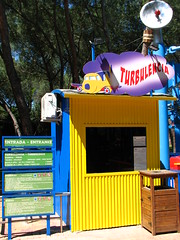 By the end of the season I think I made an important revelation, that it wasn’t the number at the end of the list that mattered, but it was the content of the list itself. Opened to trying coasters I normally would have given the cold shoulder, I found my horizons and tastes were beginning to grow, like the picky teenager that eventually discovered that although their usual comfort food might still remain their favorites, there were new, previously unimagined pleasures to be found in culinary confections that didn’t previously meet their high and lofty standards of what was worthy to touch their tastebuds. I’ll acknowledge that there was probably some wisdom in avoiding coasters such as Magic Mountain’s Psychone or Great Adventure’s Viper when had a chance, but a significant part of me still feels regret at passing up the experience to ever at least try these coasters once, even if the experience did in fact end up being a bad one. Whatever doesn’t kill me can only make me stronger, right?
By the end of the season I think I made an important revelation, that it wasn’t the number at the end of the list that mattered, but it was the content of the list itself. Opened to trying coasters I normally would have given the cold shoulder, I found my horizons and tastes were beginning to grow, like the picky teenager that eventually discovered that although their usual comfort food might still remain their favorites, there were new, previously unimagined pleasures to be found in culinary confections that didn’t previously meet their high and lofty standards of what was worthy to touch their tastebuds. I’ll acknowledge that there was probably some wisdom in avoiding coasters such as Magic Mountain’s Psychone or Great Adventure’s Viper when had a chance, but a significant part of me still feels regret at passing up the experience to ever at least try these coasters once, even if the experience did in fact end up being a bad one. Whatever doesn’t kill me can only make me stronger, right?
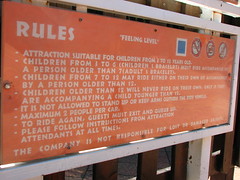 These thoughts ran through my head as I tried to justify to myself what seemed to be a new low: waiting outside the platform of the Zamperla suspended Mini-mouse Turbulencia in Parque de Atracciones Madrid’s children section, as I tried to conjure what limited Spanish I could remember to explain to the friendly but persistent ride operator refusing me admittance on the basis that it was “solo por niños” why I should be allowed special exception. “¿Cómo se dice credit en español?” A rational discussion involving mostly hand gestures with words neither party
These thoughts ran through my head as I tried to justify to myself what seemed to be a new low: waiting outside the platform of the Zamperla suspended Mini-mouse Turbulencia in Parque de Atracciones Madrid’s children section, as I tried to conjure what limited Spanish I could remember to explain to the friendly but persistent ride operator refusing me admittance on the basis that it was “solo por niños” why I should be allowed special exception. “¿Cómo se dice credit en español?” A rational discussion involving mostly hand gestures with words neither party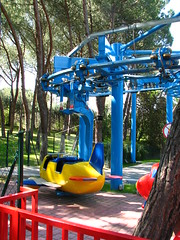 understood followed while a family with one small child went to ride with his dad. While none of the other adult non-riders could speak any English, they evidently could sympathize with the motives for why a foreign college student would want to travel to Madrid to ride children’s coasters. “¿Para la fotografía?” they asked, indicating my camera. “Oh, uh… sí,” I said; I had not been intending to take pictures onride as I didn’t want to potentially violate another park rule in my quest to get all six credits of the day, but this seemed to ticket to getting me on the ride, as they then agreed to let their child ride with me a second time so that I could secure the on-ride photographs I evidently so desired. This was also possibly the first time I’ve ever witnessed in which on-ride photography was mandatory to ride. Since I’m not about to let all that hard work go to waste just for an extra number to add to my list, here’s the POV evidence of my ride on the (actually somewhat curious and unique, if not totally boring) children’s coaster Turbulencia:
understood followed while a family with one small child went to ride with his dad. While none of the other adult non-riders could speak any English, they evidently could sympathize with the motives for why a foreign college student would want to travel to Madrid to ride children’s coasters. “¿Para la fotografía?” they asked, indicating my camera. “Oh, uh… sí,” I said; I had not been intending to take pictures onride as I didn’t want to potentially violate another park rule in my quest to get all six credits of the day, but this seemed to ticket to getting me on the ride, as they then agreed to let their child ride with me a second time so that I could secure the on-ride photographs I evidently so desired. This was also possibly the first time I’ve ever witnessed in which on-ride photography was mandatory to ride. Since I’m not about to let all that hard work go to waste just for an extra number to add to my list, here’s the POV evidence of my ride on the (actually somewhat curious and unique, if not totally boring) children’s coaster Turbulencia:
 Knowing I had at least one more coaster with single-rider age limitations, I followed them to the next attraction Vagones Locos, where a similar request was made. “¿Los dos?” they asked with a friendly laugh, and once again I had a more youthful riding companion to further enable my addiction to obscure children’s coaster credits. Defending my ego I rationalized that now no matter how many roller coasters I will ever ride in my lifetime the number will be two more than it otherwise would have been and… AHHH, I’ve turned into a guilty, shameless, dirty credit whore! One quick but slightly related thought before the second kiddie coaster POV, am I the only English speaker whose imagined translation of what “Vagones Locos” might mean was something assuredly more risqué than what was actually intended? But I digress…
Knowing I had at least one more coaster with single-rider age limitations, I followed them to the next attraction Vagones Locos, where a similar request was made. “¿Los dos?” they asked with a friendly laugh, and once again I had a more youthful riding companion to further enable my addiction to obscure children’s coaster credits. Defending my ego I rationalized that now no matter how many roller coasters I will ever ride in my lifetime the number will be two more than it otherwise would have been and… AHHH, I’ve turned into a guilty, shameless, dirty credit whore! One quick but slightly related thought before the second kiddie coaster POV, am I the only English speaker whose imagined translation of what “Vagones Locos” might mean was something assuredly more risqué than what was actually intended? But I digress…
The rest of the day was decidedly more normal. The side of the park that I entered on which is nearest the large Zona Infantil was almost completely empty when I first arrived, promises of very short lines further back in the park on the larger attractions. Before so doing, I made a cycle on the Elevated Railway that tours above the children’s section, which this there was no problem for my inclusion (no I’m not going to credit it).
My first major attraction was Vértigo, the freshly installed MACK standard model wild mouse, relocated in 2009 from Bobbejaanland. Nothing much to comment on here, other than it seemed to be a nice “middle grounds” roller coaster for the park, and the switchbacks and drops seemed to be set at the usual level of mild brutality. A neat desert sandstone style made up the queue, apparently to help it fit in the Zona de la Naturaleza better.
 Parque de Atracciones is slightly unusual in that despite the occasional singularly themed ride and how most of the structures and landscaping are certainly well-polished, it has a very vanilla presentation as an ‘attractions park’, yet it’s still subdivided into several theme zones. Rather than enter into different worlds, you enter into zones designed for a different customer demographic. There was the Zona Infantil, a larger corner of the park designed exclusively for children’s rides. The Zona Tranquilidad has low key, family friendly rides spread between gardens and fountains, similar to Zona de la Naturaleza, which apart from Vértigo has mostly themed water rides and a large botanical showcase. Then there’s the Zona del Maquinismo, literally the Machinery Zone, figuratively Zone of the Big Expensive Thrill Rides. This is where I would be spending the lion’s share of my time today. I appreciate this sort of infrastructure, it means less walking for those who are interested in a single type of attraction, but if you do want to explore other areas you’ll encounter some vastly different ambiances,
Parque de Atracciones is slightly unusual in that despite the occasional singularly themed ride and how most of the structures and landscaping are certainly well-polished, it has a very vanilla presentation as an ‘attractions park’, yet it’s still subdivided into several theme zones. Rather than enter into different worlds, you enter into zones designed for a different customer demographic. There was the Zona Infantil, a larger corner of the park designed exclusively for children’s rides. The Zona Tranquilidad has low key, family friendly rides spread between gardens and fountains, similar to Zona de la Naturaleza, which apart from Vértigo has mostly themed water rides and a large botanical showcase. Then there’s the Zona del Maquinismo, literally the Machinery Zone, figuratively Zone of the Big Expensive Thrill Rides. This is where I would be spending the lion’s share of my time today. I appreciate this sort of infrastructure, it means less walking for those who are interested in a single type of attraction, but if you do want to explore other areas you’ll encounter some vastly different ambiances,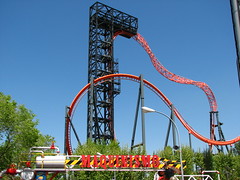 unlike mainstream philosophies of park design which believe that crowd control necessarily require every midway to be as homogenized in attraction line-up and density to the others as possible. However, this approach does have one major drawback: for most parks, the big thrill rides are what attracts the largest percentage of guests, their marketing delusions of being “for every member of the family” notwithstanding. This meant that while the quieter sections where almost too quiet and empty for a sunny spring day like this, Zona del Maquinismo exhibited a healthy bustle of mostly local teenagers. By no means does this imply that there were long lines, it was still an early season Thursday, although the contrast in crowds did lead to some uneven capacity issues.
unlike mainstream philosophies of park design which believe that crowd control necessarily require every midway to be as homogenized in attraction line-up and density to the others as possible. However, this approach does have one major drawback: for most parks, the big thrill rides are what attracts the largest percentage of guests, their marketing delusions of being “for every member of the family” notwithstanding. This meant that while the quieter sections where almost too quiet and empty for a sunny spring day like this, Zona del Maquinismo exhibited a healthy bustle of mostly local teenagers. By no means does this imply that there were long lines, it was still an early season Thursday, although the contrast in crowds did lead to some uneven capacity issues.
 Time for a ride with hair on it, so my first attraction would be the Tornado, one of only two ‘standard’ inverted coasters (both named Tornado) Intamin would ever sell, a slightly odd fact given the scope of Intamin’s influence and the popularity of the inverted genre, but perhaps with good reason. While I can’t speak for the much better-looking coaster in Finland, their work in Spain suggests that they combined the main weaknesses from each of their main competitors while finding nothing to improve upon. Overbearing restraints that exacerbate a propensity towards a rough, uncalibrated ride, like on Vekoma’s inverts? Seen, and raised: the vehicles feature two seat rows per wheelbase, rather than the articulating single-row design found on all other inverted coasters. How about an unimaginative and purely utilitarian approach to element sequencing with no respect for pacing,
Time for a ride with hair on it, so my first attraction would be the Tornado, one of only two ‘standard’ inverted coasters (both named Tornado) Intamin would ever sell, a slightly odd fact given the scope of Intamin’s influence and the popularity of the inverted genre, but perhaps with good reason. While I can’t speak for the much better-looking coaster in Finland, their work in Spain suggests that they combined the main weaknesses from each of their main competitors while finding nothing to improve upon. Overbearing restraints that exacerbate a propensity towards a rough, uncalibrated ride, like on Vekoma’s inverts? Seen, and raised: the vehicles feature two seat rows per wheelbase, rather than the articulating single-row design found on all other inverted coasters. How about an unimaginative and purely utilitarian approach to element sequencing with no respect for pacing,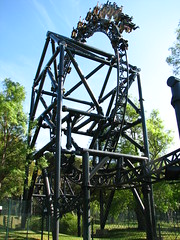 as on some of B&M’s lesser creations? Seen, and also raised: the layout is even more conservative and pointless in its plugging of generic elements into one another with slower transition times.
as on some of B&M’s lesser creations? Seen, and also raised: the layout is even more conservative and pointless in its plugging of generic elements into one another with slower transition times.
The longer cars are possibly partly to blame for the disappointing design, as they make articulation around banking changes more cumbersome, and as such most of the turns and transitions have a much wider, sweeping design that gives the experience a rather bland dynamic. A gentle, curving first drop builds enough speed to jostle us back and forth a bit to keep us on edge, and then a vertical loop with extravagantly excessive supports rides exactly like any other vertical loop you could experience around the world. A wide fan turn is all that separates the first vertical loop from the identical second. It seems to be emulating the Batman layout somewhat, although with the tight first drop and rapid pace of the heartline roll replaced with much duller maneuvers. Another basic sweep turn leads into the rides most interesting (but also often the most jarring) element, a corkscrew flat spin, 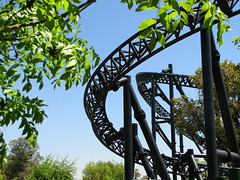 which is the only point where g-forces other than staid positives and rapid laterals due to vehicular shunting come into play. It finished up with an utterly weak s-turn into an utterly uninspired (and also weak) helix finale, before it comes sliding into a set of magnetic brakes.
which is the only point where g-forces other than staid positives and rapid laterals due to vehicular shunting come into play. It finished up with an utterly weak s-turn into an utterly uninspired (and also weak) helix finale, before it comes sliding into a set of magnetic brakes.
 However, since the suspension generally wasn’t too shaky and alone the three loops could be entertaining in the moment so it wasn’t a displeasurable ride, only an underwhelming one. I rode it about ten times throughout the day, more than the other two big coasters in the park, but that had more to do with the longer train making it the highest capacity ride in the park rather than because of any preference of personal taste (that it was a unique design for me also helped my interest in scoring rerides). Also a logistical note, if you’re a single rider waiting for the front seat (the train is loaded on a first-come, first-serve basis) but you have a camera with you that you need to place in the bins, you have to dash to reserve your row, wait until most of the rows
However, since the suspension generally wasn’t too shaky and alone the three loops could be entertaining in the moment so it wasn’t a displeasurable ride, only an underwhelming one. I rode it about ten times throughout the day, more than the other two big coasters in the park, but that had more to do with the longer train making it the highest capacity ride in the park rather than because of any preference of personal taste (that it was a unique design for me also helped my interest in scoring rerides). Also a logistical note, if you’re a single rider waiting for the front seat (the train is loaded on a first-come, first-serve basis) but you have a camera with you that you need to place in the bins, you have to dash to reserve your row, wait until most of the rows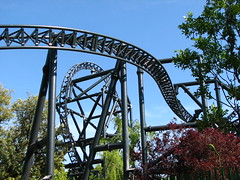 behind you have been settled into (do not lower your restraint yet),
behind you have been settled into (do not lower your restraint yet),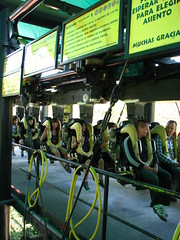 and then sprint to the loose item drop and back because the Spanish teens in rows behind you will take the opportunity to move into your momentarily vacated spot if you’re unwilling to demonstrate your feet of fire. I speak from experience of doing it the correct way, although it was close to being a photo finish.
and then sprint to the loose item drop and back because the Spanish teens in rows behind you will take the opportunity to move into your momentarily vacated spot if you’re unwilling to demonstrate your feet of fire. I speak from experience of doing it the correct way, although it was close to being a photo finish.
A generous number of flat rides are scattered between the coasters, such as the Tifón, a Zamperla Disk-O which reflecting my experience with other models I was predictably indifferent to; and the Rotor, a HUSS Condor which provided some nice photo opportunities from the top provided you were quick/lucky with the shutter amidst the scrambler-like spinning.
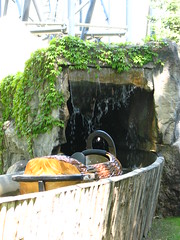 El Aserradero was something of a reduced scale log flume, although the narrower troughs, smaller boats and shorter drops didn’t stop it from being any less wet. One slightly horrifying feature (for me, at least) was a ‘trick’ waterfall over the end of a tunnel that had a bad timer causing the water to delay several seconds after it was triggered to turn off before it actually did. The result was I had to quickly slide as far back into the log as possible where I just narrowly managed to avoid getting a second shower for the day. Once was enough for that one. Another attraction more congenial to my personal tastes and tolerance for wetness was La Cueva de las Tarántulas, an interactive darkride set in a cave beneath the larger eponymous spinning coaster that used a suspended car configuration.
El Aserradero was something of a reduced scale log flume, although the narrower troughs, smaller boats and shorter drops didn’t stop it from being any less wet. One slightly horrifying feature (for me, at least) was a ‘trick’ waterfall over the end of a tunnel that had a bad timer causing the water to delay several seconds after it was triggered to turn off before it actually did. The result was I had to quickly slide as far back into the log as possible where I just narrowly managed to avoid getting a second shower for the day. Once was enough for that one. Another attraction more congenial to my personal tastes and tolerance for wetness was La Cueva de las Tarántulas, an interactive darkride set in a cave beneath the larger eponymous spinning coaster that used a suspended car configuration.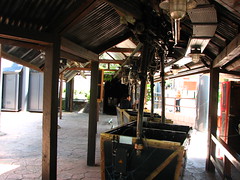 The ride has obviously existed long prior to the tarantula make-over, the rickety hanging cars with humming motors giving it their all to propel us forward complementing the cheap, retro-dark ride interior of the cavern. Nevertheless, large quantities of strobe lighting and heavy mechanical spiders lunging towards riders with loud audio queues was more than enough to properly test one’s automatic nervous reflexes several times, demonstrating once again that low-budget camp thrills can still hold their own against multimillion
The ride has obviously existed long prior to the tarantula make-over, the rickety hanging cars with humming motors giving it their all to propel us forward complementing the cheap, retro-dark ride interior of the cavern. Nevertheless, large quantities of strobe lighting and heavy mechanical spiders lunging towards riders with loud audio queues was more than enough to properly test one’s automatic nervous reflexes several times, demonstrating once again that low-budget camp thrills can still hold their own against multimillion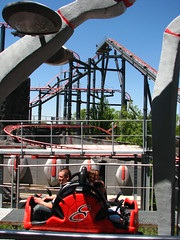 dollar sets and cutting edge special effects.
dollar sets and cutting edge special effects.
No expense was spared, however, for La Tarántula, which to the best of my knowledge is the largest spinning coaster ever built. I certainly makes a game effort to impress before one even boards the bright red and black coaster car, a large mechanical tarantula standing guard over the entrance, with a lifthill towering in the background that they claim is only 71 feet tall (statistically the tallest ever built for a spinner) but one would swear by appearances it topped out at least 100 above terra firma. Perhaps the 71 foot tall statistic refers only to the length of the drop, which pulls up sooner to accommodate the dark ride building? Something about seeing the fragile, narrow-gauge two-tube track with single cars spinning on a ride of this scale just doesn’t seem natural.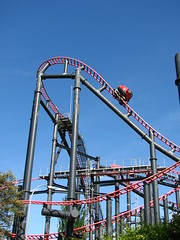
Yet the feelings of grandeur were somewhat marred for me by the witness of some of the silliest, most inefficient operations. It wasn’t just that only three cars were on the track, that was low but still manageable given the relatively light crowds. Two employees were on duty that day, one on the loading platform, one on the unloading platform. Where lies the problem with this is I think there’s a required minimum of three, as one also needs to be inside the control room to dispatch the cars. Therefore, the operator on the loading platform would have to load and dispatch only two of the three cars at a time, go inside the control booth to monitor those two cars until
cars were on the track, that was low but still manageable given the relatively light crowds. Two employees were on duty that day, one on the loading platform, one on the unloading platform. Where lies the problem with this is I think there’s a required minimum of three, as one also needs to be inside the control room to dispatch the cars. Therefore, the operator on the loading platform would have to load and dispatch only two of the three cars at a time, go inside the control booth to monitor those two cars until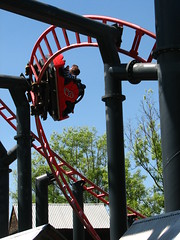 both had made it back to the station and been unloaded, then usher guests into the next two set, and repeat the cycle. Since the ride isn’t exactly short (it’s the only spinning coaster with a 2000+ ft. long layout) this resulted
both had made it back to the station and been unloaded, then usher guests into the next two set, and repeat the cycle. Since the ride isn’t exactly short (it’s the only spinning coaster with a 2000+ ft. long layout) this resulted only in some horrendously slow moving queues, alleviated slightly by the fact that at several times throughout the day the wait would only have a single group of four ahead of me anyway, but if there was even a single spike in demand that resulted in some thirty people joining the queue it became a virtually intolerable queue. I think I still managed to get about six cycles under my belt, and I wish I could have gotten more because it’s a fun coaster.
only in some horrendously slow moving queues, alleviated slightly by the fact that at several times throughout the day the wait would only have a single group of four ahead of me anyway, but if there was even a single spike in demand that resulted in some thirty people joining the queue it became a virtually intolerable queue. I think I still managed to get about six cycles under my belt, and I wish I could have gotten more because it’s a fun coaster.
Sadly despite the impressive scale of this investment, I can’t give it kudos for being one of the best spinning coasters I’ve ever been on. In fact it’s perhaps because of the impressive scale that this coaster suffers. The elements are too long and drawn out, with slower transition timing to accommodate the higher average speed. Spinning coasters thrive on quick,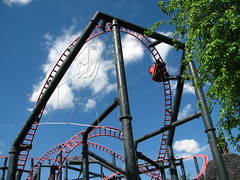 sudden turns to get the cars spinning and the riders disoriented, that’s partly why the concept originated on traditional wild mouse layouts. Tarántula spun but only at a slow, steady rate, and with gently curving, relatively flat track meant that the added angular momentum did little to make the dynamics more colorful. There were a couple moments around some of the block brakes where some quickly banked s-curves would throw a bit of variation in, although these generally did little to accumulate significant spinning momentum to sustain the car afterwards. I eventually found the one moment that made rerides exceptionally worthwhile came halfway in the layout after the second block brake; a smaller fan curve set inside larger signature maneuver that opens the layout had a small jolt of banking right before the start of the turn. However,
sudden turns to get the cars spinning and the riders disoriented, that’s partly why the concept originated on traditional wild mouse layouts. Tarántula spun but only at a slow, steady rate, and with gently curving, relatively flat track meant that the added angular momentum did little to make the dynamics more colorful. There were a couple moments around some of the block brakes where some quickly banked s-curves would throw a bit of variation in, although these generally did little to accumulate significant spinning momentum to sustain the car afterwards. I eventually found the one moment that made rerides exceptionally worthwhile came halfway in the layout after the second block brake; a smaller fan curve set inside larger signature maneuver that opens the layout had a small jolt of banking right before the start of the turn. However,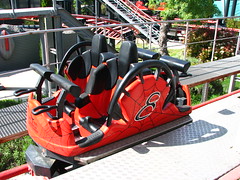 on the way out the track would suddenly steeply dive at least three times as far down into a concrete cave between the dark ride building this whole segment of the layout is built on top of, with a little banking switchback thrown in. The result never failed to surprise and delight and was easily the highlight of the entire coaster, especially since depending on the direction on was facing when encountering this drop significantly varied the experience. Perhaps my overall opinion would have been a bit more favorable had I not always been recently put-off by lousy operations that otherwise would have made this a walk-on attraction all day, but its spunky character still prove why I wish more American parks would build large custom spinning coasters à la Tarántula, Winjas or Dragon’s Fury.
on the way out the track would suddenly steeply dive at least three times as far down into a concrete cave between the dark ride building this whole segment of the layout is built on top of, with a little banking switchback thrown in. The result never failed to surprise and delight and was easily the highlight of the entire coaster, especially since depending on the direction on was facing when encountering this drop significantly varied the experience. Perhaps my overall opinion would have been a bit more favorable had I not always been recently put-off by lousy operations that otherwise would have made this a walk-on attraction all day, but its spunky character still prove why I wish more American parks would build large custom spinning coasters à la Tarántula, Winjas or Dragon’s Fury.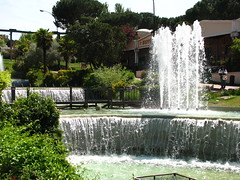
The local population was starting to fill in the queues for the major thrill rides so I decided to take a break from the Zona del Maquinismo and see what the Zona Tranquilidad had to offer. Tranquil it was, almost no one from the thrill ride section venturing into this area which was centered around a large reservoir with waterfalls and fountains. I first ended up in the queue for the Zamperla Zeppelin, a suspended monorail which takes riders (or in my case, rider) on a slow aerial tour of the midways. Also nearby for those looking to take in the sights was the NoriaVision, an erector-set Ferris Wheel that offers some decent views of both the park’s thrill ride skyline and the skyline for the city of Madrid.
 A nearby haunted walkthrough attraction seemed inviting until I discovered it wasn’t included on the pay-one-price admission, so I ended up at the entrance of a bizarre looking
A nearby haunted walkthrough attraction seemed inviting until I discovered it wasn’t included on the pay-one-price admission, so I ended up at the entrance of a bizarre looking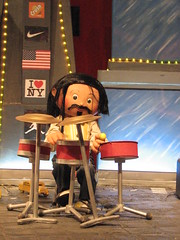 indoor family attraction known simply as Fantasía. What it was I learned was a sort of low-budget Small World knock-off apparently set in space with cartoon aliens (at least that’s what the platform suggested, the rest was just a direct copying of ‘it’s a small world’ but with an even more cloying song.) I normally dislike it when parks copy the idea of another park, normally Disney, but this one was just so above-the-title and beyond-the-stars weird that the glazed-face bewilderment I experienced was well beyond the level of anything Disney has managed to accomplish. So, well done Parque de Atracciones Madrid, you’ve accomplished something in your toeing of intellectual property I previously though not possible outside of China.
indoor family attraction known simply as Fantasía. What it was I learned was a sort of low-budget Small World knock-off apparently set in space with cartoon aliens (at least that’s what the platform suggested, the rest was just a direct copying of ‘it’s a small world’ but with an even more cloying song.) I normally dislike it when parks copy the idea of another park, normally Disney, but this one was just so above-the-title and beyond-the-stars weird that the glazed-face bewilderment I experienced was well beyond the level of anything Disney has managed to accomplish. So, well done Parque de Atracciones Madrid, you’ve accomplished something in your toeing of intellectual property I previously though not possible outside of China.
Truthfully, Zona Tranquilidad sort of sucked in that there was little to see or do besides low-end ‘tranquil’ attractions, and if I just want to peace out I’m sure there’s many better places in Spain to do that than in an amusement park. Back to Zona del Maquinismo for me, where La Lanzadera, an Intamin second-generation drop tower was calling my name. Really no surprises here, which is to say that the singular surprise of waiting far above the ground at the top of the tower wondering when the latch will release is still in effect. Some other flat rides such as a HUSS Frisbee and Top Spin were present nearby, but I skipped these in favor of getting more time with the starring attraction in a park dedicated just to atracciones, Abismo.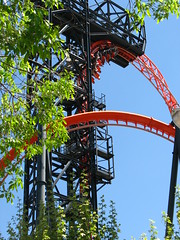
All right, I’ll be honest, the first time I rode Abismo that day I got off thinking I really didn’t like it that much. The primary offender was a wide, curved lapbar that lowers from the side of the train and ratchets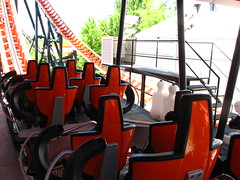 like a corset on the first high-G pullout to the point I was gasping for breath by the end. On my second ride I was able to hold the bar up with my hands but this distracted me attention away from the ride experience itself, but on my third ride I figured out how to position my arm so that as I held onto the bar my elbow was propped against the edge
like a corset on the first high-G pullout to the point I was gasping for breath by the end. On my second ride I was able to hold the bar up with my hands but this distracted me attention away from the ride experience itself, but on my third ride I figured out how to position my arm so that as I held onto the bar my elbow was propped against the edge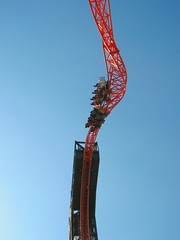 of the seat so that I could keep the restraint an inch or two off my lap for the whole ride while not having to consciously concern myself too much with the ergonomics of the vehicle design, and by that point I discovered a thrill ride that could be described with the following adjectives: Intense. Powerful. Intimidating. Sublime. Innovative. Original. Over Too Quickly.
of the seat so that I could keep the restraint an inch or two off my lap for the whole ride while not having to consciously concern myself too much with the ergonomics of the vehicle design, and by that point I discovered a thrill ride that could be described with the following adjectives: Intense. Powerful. Intimidating. Sublime. Innovative. Original. Over Too Quickly.
There’s really not a moment on Abismo that’s quite like any other roller coaster I’ve ever been on. The first vertical lift has shades of the claustrophobic, head-pinned-against-the-seat-back, can’t-see-the-ground psychological sensation that’s found on Fahrenheit or Mystery Mine, but Abismo one-ups those examples by rather than wimping out with a regular lift hill crest and drop, this one only gets more freaky at the apex once it slowly flips us all the way upside so we’re hanging delicately 150 above the ground no over the shoulder restraint, one panicking when they wonder if their cell phone is really all that secure in their pocket. With apologies to the ill-fated Maximum RPM, while normally it’s not a good sign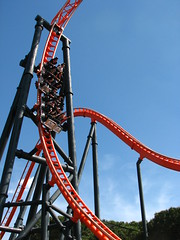 when a lift hill is the highlight of the ride, in the case of Abismo can in no way be interpreted as snark; Abismo has already accomplished more unique thrills before it disengages the chain lift than many modern steel coaster can before they get to the brake. (How did Maurer Söhne managed to follow this up with Hollywood Rip, Ride Rocket, a coaster that’s not only too afraid to go upside but whose first drop is shallower than the chain lift?)
when a lift hill is the highlight of the ride, in the case of Abismo can in no way be interpreted as snark; Abismo has already accomplished more unique thrills before it disengages the chain lift than many modern steel coaster can before they get to the brake. (How did Maurer Söhne managed to follow this up with Hollywood Rip, Ride Rocket, a coaster that’s not only too afraid to go upside but whose first drop is shallower than the chain lift?)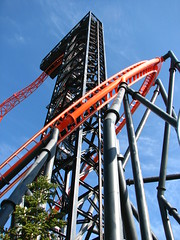
The barrel roll at the top (inverted to start and end upside down) perpetuates the building uneasiness as it is more than 100 feet above the ground, completely unsupported, and the linear heartline path means we’re whipped around to the side as our orientation with the gravitational pull once pulling us straight out of our seats is suddenly changing relative direction. The cars gain a fast clip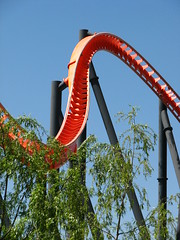 before the second inversion, the promise of an explosive introduction finally coming to a head with a massively high-speed pullout, over 65 miles per hour and positive g-forces as strong as I have ever felt on a first drop (RCDb is telling me it’s 4 g’s
before the second inversion, the promise of an explosive introduction finally coming to a head with a massively high-speed pullout, over 65 miles per hour and positive g-forces as strong as I have ever felt on a first drop (RCDb is telling me it’s 4 g’s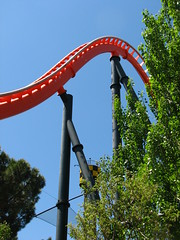 but that honestly seems weak, perhaps it seems more significant because it’s sustained for more than a second). While my ears are on overload as the two-car vehicle roars loud enough to drown out a full-sized B&M train, my eyes are struggling against the tunnel vision as we angle back up and around what seems to be an inclined loop, revealing itself by a twist before the top to be a severely overbanked turn, perhaps only a few degrees shy of qualifying as an Immelmann inversion.
but that honestly seems weak, perhaps it seems more significant because it’s sustained for more than a second). While my ears are on overload as the two-car vehicle roars loud enough to drown out a full-sized B&M train, my eyes are struggling against the tunnel vision as we angle back up and around what seems to be an inclined loop, revealing itself by a twist before the top to be a severely overbanked turn, perhaps only a few degrees shy of qualifying as an Immelmann inversion.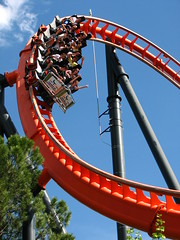 At the twist we’re finally given a reprieve from the G-forces, me thankful my elbow didn’t slip and my arm is still propping my lapbar up high enough so I can get more oxygen. Another fast, forceful pullout leads up into a moment of exquisitely strong airtime,
At the twist we’re finally given a reprieve from the G-forces, me thankful my elbow didn’t slip and my arm is still propping my lapbar up high enough so I can get more oxygen. Another fast, forceful pullout leads up into a moment of exquisitely strong airtime,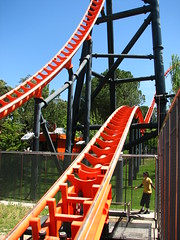 possibly putting more force up against the lapbars than we did when we were hanging upside down at the top of the lift. A final overbanked turn seems like child’s play before we’re diving back to ground level to what I thought to be the end of the ride.
possibly putting more force up against the lapbars than we did when we were hanging upside down at the top of the lift. A final overbanked turn seems like child’s play before we’re diving back to ground level to what I thought to be the end of the ride.
Now, I was very familiar with how a cycle on this coaster functions from watching videos and observing it in person before I rode, but maybe all those G-forces temporally fried enough of my synapses to make me forget that this flat stretch of track after the final overbank was not a brake run. Instead of slowing down the train speeds up as a nasty little second dip sends our posteriors skyward once again as the station roof briefly invites decapitation. “Oh yeah, there’s a reason they’re only running one train on this today!” Flying back through the station at nearly 60 mph is an experience that seems… unnatural, for a complete circuit coaster that is. We power back up the vertical lifthill where the rocket final thuds to a halt. “Umph,” everyone utters, then turns to their neighbor and starts excitedly chattering as the lift slowly eases us back down and right-side-up.
We power back up the vertical lifthill where the rocket final thuds to a halt. “Umph,” everyone utters, then turns to their neighbor and starts excitedly chattering as the lift slowly eases us back down and right-side-up.
I don’t want to oversell Abismo too much, but it is very exciting when you’ve been jaded by over three-hundred coaster credits world-wide and at the end of your day discover one that’s a legitimate thrill ride and manages an experience that still seems extreme. There’s not much to say about it being a complete experience, as given the queue times faced waiting for a single 12-passenger train to complete its circuits, once on board the ride is over before you’ve even been able to prepare for its start. In that way I think of its closest spiritual kinship being something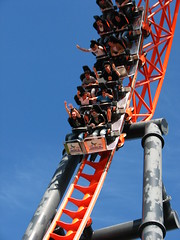 like Storm Runner, where a short ride time is packed with as many exhilarating ideas as possible before it pulls a Kurt Cobain and ends itself before it has a chance to become redundant and disappointing. Storm Runner is by far the superior example of this sort of existential roller coaster philosophy, as that one markedly improves with each successive element, while Abismo puts its best acts at the front of the ride and gets progressively (though not significantly) weaker as it goes on; plus nothing but nothing on Abismo could ever compare to the five-second sustained weightlessness over a crest through a heartline roll and down a flying snake dive.
like Storm Runner, where a short ride time is packed with as many exhilarating ideas as possible before it pulls a Kurt Cobain and ends itself before it has a chance to become redundant and disappointing. Storm Runner is by far the superior example of this sort of existential roller coaster philosophy, as that one markedly improves with each successive element, while Abismo puts its best acts at the front of the ride and gets progressively (though not significantly) weaker as it goes on; plus nothing but nothing on Abismo could ever compare to the five-second sustained weightlessness over a crest through a heartline roll and down a flying snake dive.
Regardless, I liked it enough to pick up an Abismo t-shirt at the main gift shop on my way back to the exit, which I timed once Abismo had broken down yet again, Tarántula was facing at least a 45 minute wait, and Tornado had been experienced once more than necessary to warrant another reride. Overall a fruitful day in Madrid, as I now had six more credits to prove my opinion just that much better to yours.






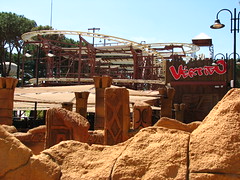












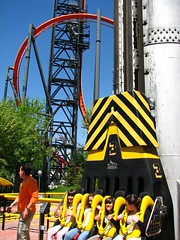
Comments